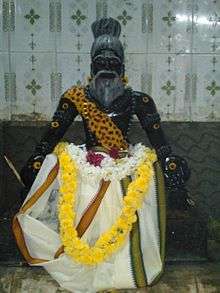Tirumular
Tirumular (also spelt Thirumoolar etc., originally known as Suntaranāthar) was a Tamil Shaivite mystic and writer, considered one of the sixty-three Nayanmars and one of the 18 Siddhars. His main work, the Tirumantiram (also sometimes written Tirumanthiram, Tirumandhiram, etc.), which consists of over 3000 verses, forms a part of the key text of the Tamil Shaiva Siddhanta, the Tirumurai.

Om symbol Om symbol | ||
|---|---|---|
| The twelve volumes of Tamil Śaiva hymns of the sixty-three Nayanars | ||
| Parts | Name | Author |
| 1,2,3 | Thirukadaikkappu | Sambandar |
| 4,5,6 | Thevaram | Thirunavukkarasar |
| 7 | Thirupaatu | Sundarar |
| 8 | Thiruvasakam & Thirukkovaiyar | Manickavasagar |
| 9 | Thiruvisaippa & Tiruppallaandu | Various |
| 10 | Thirumandhiram | Thirumular |
| 11 | Various | |
| 12 | Periya Puranam | Sekkizhar |
| Paadal Petra Sthalam | ||
| Paadal Petra Sthalam | ||
| Rajaraja I | ||
| Nambiyandar Nambi | ||
Chronology
The dates of Tirumular's life are controversial, and because his work makes reference to so many currents of religious thought, the dates that different scholars assign are often appealed to for anchoring the relative chronology of other literature in Tamil and Sanskrit. Verse 74 of the Tirumantiram makes the claim that Tirumular lived for 7 yugams before composing the Tirumantiram.[1]
Some are therefore inclined to place his composition well before the Common Era. The scholar and lexicographer S. Vaiyapuripillai, however, suggested that he probably belonged to the beginning of the eighth-century CE, pointing out that Tirumular could not very well be placed earlier given that he appears to refer to the Tevaram hymns of Sambandar, Appar and Sundarar, that he used "very late words" and that he made mention of the weekdays.[2]
Others wish to push the date still later: Dominic Goodall, for instance, appears to suggest, on the grounds of religious notions that appear in the work with Sanskrit labels for which a certain historical development can be traced in other datable works, that the Tirumantiram cannot be placed before the 11th- or 12th-century CED.[3] Yet another view, alluded to for instance by Vaiyapuripillai (ibid.), is that the text may contain an ancient core, but with "a good number of interpolated stanzas" of later date. Whatever the case, allusions to works and ideas in the Tirumantiram cannot, at least for the moment, be used as useful indicators of their chronology.
History
SundaraNathar,[4] as the saint is known, was a Yogi originally from ThenMadurai (currently South Madurai - Tamil Nadu) who travelled to Mount Kailaayam and was initiated directly by Lord Sivan. After spending many years in Mount Kailaayam, he undertook a journey under the order of Lord Sivan to Thamizhakam, to meet his contemporary sage friend Agathiyar in Pothigai Hills (also called Pothiya Malai of ancient Tamil land). While on his way, near Sathanur Village (a village near Aaduthurai of Cauveri Delta area), he saw a group of cows crying. He went near to the cows, only to discover that their cowherd, Moolan was dead bitten by a snake. He was really touched by the sight of the cows that wept in sorrow and decided to use his Oham (yogic) power and move his soul from his body to that of the dead cowherd's body. He left his body inside a tree log. On waking up from the body of cowherd, the cows became happy and so he navigated them to the village. Then he returned to the place where he left his body, to return to his own body. To his surprise, his actual body had disappeared away from the tree log nowhere to be found. During this moment, he heard a divine voice from the sky (Lord Sivan) who told him that He was the one who made his (Sundara Nathar) body to disappear. Lord Sivan told him (Sundara Nathar) the reason why He did that, and that's because Lord Sivan wanted Sundara Nathar to spread his teachings through the body of Moolan so that each and every common people would get enlightened through the knowledge spread in Moolan's body because of the simple dialect of a cowherd man using the Tamil Language compared to Sundara Nathar's own body which would involve an extremely advance and divine Tamil Language that would make it very difficult for the common people to understand and comprehend. Thus, from that day onwards he was known by the name of Thirumoolar. The cowherd was called by the name of Moolan in the village. Thus, he gained the name of Moolar, which became Thirumoolar (or Tirumular). He was deeply immersed in Thapam (Meditation) under a peepul tree in Thiruvavaduthurai and received the holy hymn verse in Tamil. 3000 of holy hymns have been documented in to the book called Tirumantiram. But the exact years of the events are not known.
See also
References
- Tirumantiram A Tamil scriptural Classic. By Tirumular. Tamil Text with English Translation and Notes, B. Natarajan. Madras, Sri Ramakrishna Math, 1991, p.12.
- Vaiyapuripillai's History of Tamil Language and Literature (From the Beginning to 1000 A.D.), Madras, New Century Book House, 1988 (after the first edition of 1956), particularly footnote 1 on p.78.
- See pp.xxix-xxx in a Preface (entitled Explanatory remarks about the Śaiva Siddhānta and its treatment in modern secondary literature) to The Parākhyatantra. A Scripture of the Śaiva Siddhānta, Dominic Goodall, Pondicherry, French Institute of Pondicherry and Ecole française d'Extrême-Orient, 2004.
- Tirumular (19 October 2016). Tirumantiram - A Tamil Scriptural Classic. ISBN 9781365471681.
External links
- Thirumanthiram with Tamil explanation — Tamil version of Thirumanthiram
- Tirumantiram — English version of Thirumanthiram